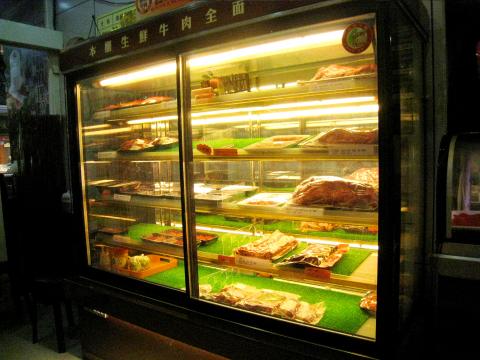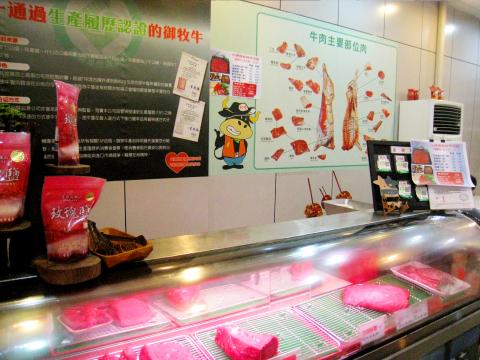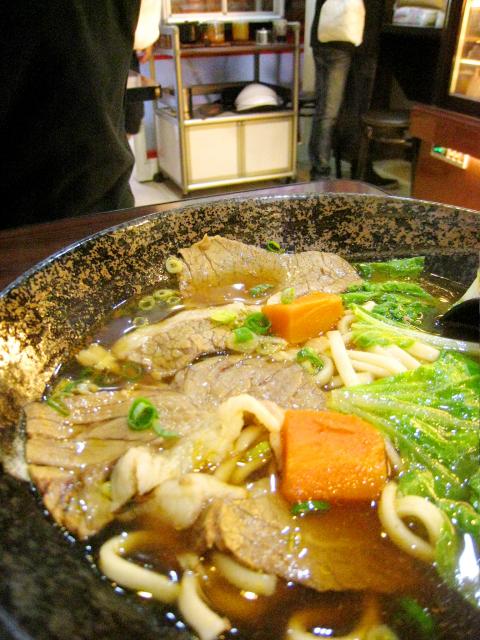Very few restaurants can boast their own slaughterhouse. Hong Jing (鈜景), a tiny stall-like establishment that is the misleading face of a substantial beef rearing and packaging operation, can and does. It might not be able to claim the same world-beating standard as USDA Prime, but it puts a premium on the freshness of its product, which is transported up to Taipei daily to provide for its signature dish of beef sashimi noodle soup (刺身牛肉麵, NT$120 to NT$150). For the record, a China Times report in 2009 quoted an anonymous “beef expert” as categorizing Hong Jing’s beef as USDA Choice standard.
Hong Jing rears its cattle on a ranch in Chiayi, and at a time when everyone is getting in a tizzy over the beef-for-visas issue with the US, the restaurant unashamedly pushes the fact that everything in the store is local beef, as it always has been. And for its signature dish, the freshness tells.
It is a remarkably simple dish, but one that can easily become addictive. It is placed before you as raw sliced beef with shreds of garnish, and then a beef stock is poured over it, cooking it slightly and bringing out the flavor. It is similar to Vietnamese beef pho in this respect, though the noodles are wheat la-mien (拉麵), and the stock is dominated by flavors of ginger, rice wine and Chinese medicinal herbs. Two qualities of beef are available, one a regular lean cut (鮮嫩肉片, NT$120), the other a more marbled cut (特饌御肉片, NT$150). The more expensive cut is worth the investment if you aren’t afraid of a little bit of fat, providing a superior melt-in-the-mouth sensation, which is a lovely contrast to the very serviceable handmade noodles.

Photo: Ian Bartholomew, taipei times
This dish is light, though a bit of oomph can be added with the addition of the restaurant’s superior chopped chili sauce. This goes brilliantly with one of Hong Jing’s more unusual side dishes of beef sinew (牛筋骨, NT$80), a true delight for those who enjoy chomping on the less flamboyant bits of the cow, especially the cartilage and tendon. It is not a dish for the faint of heart, but there is oodles of beef flavor and a splendid mixture of textures which, for better or worse, defy description.
The beef sashimi noodles are an eye opener and probably only possible at the price because of Hong Jing’s homegrown supply chain. The beef ribs on the bone with noodles (帶骨牛小排麵, NT$200) are also a rarity in Taiwan. This dish reveals the depth of flavor that can be achieved by a slow braise, especially for less tender cuts of meat.
Rather more mainstream is the very attractive streaky beef in brown soup (紅燒五花牛肉麵, NT$150), a very light version of a brown beef noodle soup. The highlight is the paper-thin slices of heavily marbled beef. The soy-flavored broth does not obscure the meaty base, but hides the hints of blood that, for those who like it, are what make the beef sashimi so memorable. It is a fine dish for those who prefer the cooked to the raw, but greater generosity with the meat, even if it meant raising the price, would make it a more satisfying dish.

Photo: Ian Bartholomew, taipei times
Hong Jing also offers a range of beef with rice and teppanyaki dishes, with everything from beef goulash (匈牙利牛肉飯, NT$80) to sirloin steak (沙朗牛排, NT$280 to NT$350). Like many establishments that are specialists in a specific produce rather than professional restaurant operators, the menu development could be improved. One of the greatest failings in this respect is the inclusion of a deep fried beef cutlet (炸牛排, NT$80) and the fried beef cutlet with rice (炸牛排飯, NT$150), which is so clearly nothing more than a thoughtless adaptation of the chicken or pork culet so popular in Taiwan. The cutlet is not offensive in any way, but it simply does not maintain the same high standard as a showcase for Taiwan-produced beef. Its primary flavors are those of batter and oil, and could easily be described as “mystery meat.”
Seating is limited at Hong Jing, and the atmosphere, the display cases of raw meat notwithstanding, is closer to that of a butcher’s shop than a restaurant. Accept that and the dining experience cannot be anything but a pleasure.

Photo: Ian Bartholomew, taipei times

June 23 to June 29 After capturing the walled city of Hsinchu on June 22, 1895, the Japanese hoped to quickly push south and seize control of Taiwan’s entire west coast — but their advance was stalled for more than a month. Not only did local Hakka fighters continue to cause them headaches, resistance forces even attempted to retake the city three times. “We had planned to occupy Anping (Tainan) and Takao (Kaohsiung) as soon as possible, but ever since we took Hsinchu, nearby bandits proclaiming to be ‘righteous people’ (義民) have been destroying train tracks and electrical cables, and gathering in villages

Swooping low over the banks of a Nile River tributary, an aid flight run by retired American military officers released a stream of food-stuffed sacks over a town emptied by fighting in South Sudan, a country wracked by conflict. Last week’s air drop was the latest in a controversial development — private contracting firms led by former US intelligence officers and military veterans delivering aid to some of the world’s deadliest conflict zones, in operations organized with governments that are combatants in the conflicts. The moves are roiling the global aid community, which warns of a more militarized, politicized and profit-seeking trend

The wide-screen spectacle of Formula One gets a gleaming, rip-roaring workout in Joseph Kosinski’s F1, a fine-tuned machine of a movie that, in its most riveting racing scenes, approaches a kind of high-speed splendor. Kosinski, who last endeavored to put moviegoers in the seat of a fighter jet in Top Gun: Maverick, has moved to the open cockpits of Formula One with much the same affection, if not outright need, for speed. A lot of the same team is back. Jerry Bruckheimer produces. Ehren Kruger, a co-writer on Maverick, takes sole credit here. Hans Zimmer, a co-composer previously, supplies the thumping

Dr. Y. Tony Yang, Associate Dean of Health Policy and Population Science at George Washington University, argued last week in a piece for the Taipei Times about former president Ma Ying-jeou (馬英九) leading a student delegation to the People’s Republic of China (PRC) that, “The real question is not whether Ma’s visit helps or hurts Taiwan — it is why Taiwan lacks a sophisticated, multi-track approach to one of the most complex geopolitical relationships in the world” (“Ma’s Visit, DPP’s Blind Spot,” June 18, page 8). Yang contends that the Democratic Progressive Party (DPP) has a blind spot: “By treating any